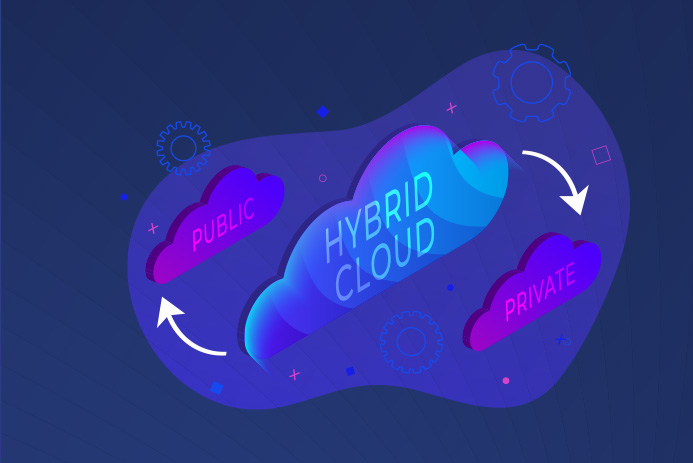Cloud
Nov 13, 2025
Leveraging Hybrid Cloud for AI & High-Performance Workloads
Artificial intelligence and high-performance computing are transforming how the world works. Every company today is becoming a computing company, driven…
Cloud
Published on June 9, 2021

For the last decade or so, cloud computing has been the focus of CIO and IT decision makers’ conversations. The pandemic that began in 2020, worldwide, however, has been an inflection point for organizations, large and small, across sectors, fast-tracking adoption of digital and cloud-led technologies, ensuring only companies who adapted to this pace of digital transformation will survive. Remote working has seeped into the mainstream culture and more than a year later, work from home seems to be here to stay. In such an environment, business leaders need technology platforms and tools enabling businesses to operate efficiently without disruption.
Cloud technologies are at the heart of this change, as security conscious businesses look for newer and emerging avenues to accelerate their digital transformation, while securing prized and sensitive business information and workloads. As per IDC Worldwide Semiannual Public Cloud Services Tracker, India’s public cloud services market, including Infrastructure as a Service (IaaS), Platform as a Service (PaaS), and Software as a Service (SaaS), touched $1.6 billion (INR 11,680 crore) for the first half of 2020. Furthermore, it states that the overall India public cloud services market is likely to reach $7.4 billion by 2024 (INR 54,020 crore), growing at a CAGR of 22.2 percent for 2020-24.
The exponential rise in data, however, demands the computing and processing needs of cloud architecture be elastic for data deployment models. This is where a new model of cloud computing comes to the rescue: Hybrid cloud. Hybrid cloud is a computing environment that combines a dedicated Compute instance or private cloud hosted in service provider DC or at captive datacenter with a public cloud, allowing data and applications to be shared between them.
Hybrid model is here to stay
As per a recent survey by IBM Institute of Business Value (IBV), hybrid cloud adoption among Indian businesses is expected to grow by 49% with the average organisation using nearly six hybrid clouds. With the increased full hybrid, multi-cloud platform technology and operating model at scale, businesses can derive 2.5 times the value compared to a single platform, single cloud vendor approach. In a nutshell, when computing and processing demands increase beyond an on-premises datacenter’s capabilities, organisations can use the cloud services to complement its existing capabilities, instantly scale capacity up or down, avoid time and cost of purchasing, installing, maintaining new servers that they may not always need.
In the coming years, Indian enterprises that are ready to bet big with an appetite for risk, will see returns from the hybrid cloud infrastructure, which is secure, interoperable, open, and free from vendor lock-in. In fact, organisations are already achieving business transformation by leveraging hybrid, multi-cloud platform technology. According to Gartner, majority of the large and midsize organisations have adopted an approach to IT that’s build on hybrid multi-cloud i.e. on-premises cloud combined with more than one public cloud.
With market dynamics shifting, partly due to the ongoing pandemic crisis, customer experience will ultimately define the brand-consumer relationship. And with a hybrid cloud infrastructure, enterprises can mine unlimited, unstructured data and run business analytics on them, especially in the retail sector. For example, India’s online retailer Myntra has been using its cloud and AI data to analyse customer preferences during the last year or so. With this, Myntra has been able to help brands by providing insights on what consumers really want, in addition to helping them move stocks quickly during the lockdown.
From an organisation-employee perspective, what we are currently seeing is a culture where every action and decision is rooted in remote working. Organisations must keep employees, where they are, while keeping them safe. Therefore, tools such as work from anywhere cloud services such as Desktop-as-a-Service/Virtual desktop infrastructure and Network-as-a-Service became must have services amid COVID-19 crisis. They also enable enterprises to align their workloads, on-premises or on cloud that is in sync with latency issues, regulations, data sovereignty and legacy data systems. In other words, for companies looking to build on their digital strategy centered around maximizing existing on-premises investments, an effective multi-edge hybrid approach by keeping the business objective and operational efficiency same is more important than ever.
Colocation providers can help accelerate your Hybrid Cloud strategy
Today, companies no longer want to deal with maintaining and operating a captive data center due to heavy upgrading costs and security concerns. Migrating to highly scalable colocation data centers is emerging as a customer preference. Additionally, customers are not just looking for rack spaces but an end-to-end solution provider who can take care of all their IT needs such as cloud, network, security, etc.
As enterprises pivot to hybrid cloud architectures, data center service providers, particularly with colocation services, are now using innovative ways to integrate their platforms with hybrid models. Global data center operators are investing in developing an ecosystem of solutions that enable clients to assemble and deploy hybrid cloud solutions on top of their traditional infrastructure.
Sensing the underlying opportunities, most of the leading data center players are developing an architecture that can evolve over time and scale up in response to newer market needs. Today, they offer public cloud as well as provide seamless integration and migration services with the likes of AWS/AZURE/GOOGLE/ORACLE cloud. And with the help of innovative models like ‘Everything-as-a-Service’, these service providers are not only serving large enterprises and cloud operators with their robust infrastructure but also offering managed services to SMEs, SOHOs, and Start-ups.
In conclusion, for businesses looking to take back power in their own hands, by custom designing their own IT infrastructure, with a practical approach realigned with their past, present, and future in mind, it’s worth making an investment in the hybrid cloud architecture.

Cloud
Nov 13, 2025
Artificial intelligence and high-performance computing are transforming how the world works. Every company today is becoming a computing company, driven…

Cloud
Nov 07, 2025
The cloud promises agility and scale. But for enterprises, it also brings the hard reality of complex management. From provisioning…

Cloud
Aug 29, 2025
Multi-cloud architecture is no longer an emerging trend; it’s an established reality. Recent industry reports show that nearly 90% of…